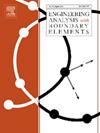G-PINNs:用于推进短期利率模型预测的贝叶斯优化gru增强物理信息神经网络
IF 4.1
2区 工程技术
Q1 ENGINEERING, MULTIDISCIPLINARY
Engineering Analysis with Boundary Elements
Pub Date : 2025-07-26
DOI:10.1016/j.enganabound.2025.106396
引用次数: 0
摘要
利率模型在金融风险管理、衍生品定价和经济预测中起着至关重要的作用。为了解决捕获复杂随机动力学的挑战,本研究提出了一种新的贝叶斯优化gru增强型物理信息神经网络(G-PINNs)架构,并与Hull-White (HW)短期利率模型相结合,以提高收益率预测、零息债券(ZCB)定价和期权定价的预测精度。提出的框架通过利用门控循环单元(GRU)进行顺序模式识别,并利用物理信息神经网络(pinn)通过HW模型的偏微分方程(PDEs)强制执行金融约束,有效地模拟利率动态中的时间依赖性变化和随机行为。为了进行实证验证,我们使用了2020年4月至2025年3月的美国国债收益率数据。为了获得最优的超参数以提高预测精度和训练效率,采用贝叶斯优化方法进行超参数整定。提出的模型优于Vanilla pinn,证明了更高的R2值和更少的误差指标(MAE, MSE, RMSE, Max &;在收益率预测、ZCB定价和期权定价中,最小误差、MSLE、Huber损失、MedAE)由数值结果表明。此外,通过配对t检验对结果进行了统计验证,这证实了G-PINNs模型的性能改进是显著的,而不是随机变化的结果。此外,还进行了5次交叉验证,以确保跨不同数据分割的稳健和无偏模型评估。本文章由计算机程序翻译,如有差异,请以英文原文为准。
G-PINNs: A Bayesian-Optimized GRU-Enhanced Physics-Informed Neural Network for Advancing Short Rate Model Predictions
Interest rate modeling plays a crucial role in financial risk management, derivative pricing, and economic forecasting. To address the challenges of capturing complex stochastic dynamics, this study proposes a novel Bayesian-Optimized GRU-Enhanced Physics-Informed Neural Network (G-PINNs) architecture, integrated with the Hull–White (HW) short-rate model, to improve the prediction accuracy of yield forecasting, zero-coupon bond (ZCB) pricing, and option pricing. The proposed framework effectively models time dependent variations and stochastic behavior in interest rate dynamics by leveraging Gated Recurrent Units (GRU) for sequential pattern recognition and Physics Informed Neural Networks (PINNs) to enforce financial constraints through partial differential equations (PDEs) of the HW model. For empirical validation, US treasury yield data from April 2020 to March 2025 is utilized. To achieve the best optimal hyperparameters to enhance both predictive accuracy and training efficiency, Bayesian Optimization (BO) is employed for hyperparameter tuning. The proposed model outperforms Vanilla PINNs as evidenced by higher values and reduced error metrics (MAE, MSE, RMSE, Max & Min error, MSLE, Huber loss, MedAE) in yield prediction, ZCB pricing, and option pricing, as indicated by the numerical results. Furthermore, the results are statistically validated through the paired t-test, which confirms that the G-PINNs model’s performance improvement is significant and not a consequence of random variation. Also, 5-fold cross-validation is performed to ensure robust and unbiased model evaluation across different data splits.
求助全文
通过发布文献求助,成功后即可免费获取论文全文。
去求助
来源期刊

Engineering Analysis with Boundary Elements
工程技术-工程:综合
CiteScore
5.50
自引率
18.20%
发文量
368
审稿时长
56 days
期刊介绍:
This journal is specifically dedicated to the dissemination of the latest developments of new engineering analysis techniques using boundary elements and other mesh reduction methods.
Boundary element (BEM) and mesh reduction methods (MRM) are very active areas of research with the techniques being applied to solve increasingly complex problems. The journal stresses the importance of these applications as well as their computational aspects, reliability and robustness.
The main criteria for publication will be the originality of the work being reported, its potential usefulness and applications of the methods to new fields.
In addition to regular issues, the journal publishes a series of special issues dealing with specific areas of current research.
The journal has, for many years, provided a channel of communication between academics and industrial researchers working in mesh reduction methods
Fields Covered:
• Boundary Element Methods (BEM)
• Mesh Reduction Methods (MRM)
• Meshless Methods
• Integral Equations
• Applications of BEM/MRM in Engineering
• Numerical Methods related to BEM/MRM
• Computational Techniques
• Combination of Different Methods
• Advanced Formulations.
 求助内容:
求助内容: 应助结果提醒方式:
应助结果提醒方式:


